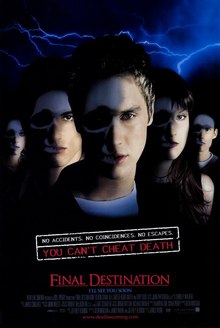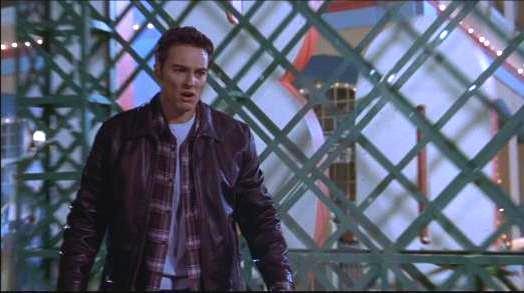At some point in life, everyone experiences a near death
moment. It might be as mundane as
avoiding a car running a red light, or as dramatic as arriving late for an
appointment to find the building engulfed in flames. Whether you credit God’s intervention or sheer luck, one
cannot deny the sense of relief felt after cheating the Grim Reaper.
The Final Destination
franchise injects a evil twist into this universal experience, the idea that
Death will not tolerate any deviation from the master plan. Though the opportunity to comment on
human mortality is obvious, the series is more interested showing how Death
will rectify the situation, often with a nastier demise than the one avoided. And the series delivers on that promise,
though the thrills are often at the expense of the rules set up earlier in the
franchise. And this includes
2000’s Final Destination, as the
finale breaks the rules set up in the opening acts.
Don't grab the towel!
The film starts as Alex Browning (Devon Sawa) prepares for
his senior trip to France. The
film spends a lot of time (compared to the rest of the franchise) on character
development, as Alex interactions with his caring parents and his best friend,
Tod (Chad Donelly). None of them
notice Alex’s growing unease concerning the flight. He’s not afraid of flying (at least no hint of this phobia
is given in the script), but small events leading up to the plane’s departure
like an airport reader board or a Muzak verion of a John Denver song, disturbs him for some reason.
This feeling of dread culminates once Alex is in his seat,
as he experiences a vivid premonition of the plane exploding during takeoff. Jolting awaken as if from a nightmare,
Alex begins experiencing events from his vision and tries to keep the plane
from leaving the terminal. All he
succeeds in doing is preventing several students, and one teacher, from being
on the plane when it explodes.
Told you so!
Alex’s prediction draws the attention of the FBI and
ostracizes him from the rest of his class, including Tod. The only person who will talk to him is
Clear Waters (Ali Larter), who left the plane because of some unexplained link,
which allowed her to experience the terror Alex experienced after his vision.
Soon, the survivors start dying in unexplained accidents,
while Alex sees cryptic clues predicting each upcoming death. Taking the advice of a local mortician
(Tony Todd), who knows quite a bit about Death’s grand plan, Alex sets out to
save the next victim in an attempt to break this new cycle of death.
I told her not to grab the towel.
The film sets up the template for the franchise, with a
spectacular disaster followed by a series of deaths set in motion by events
that would make Rube Goldberg proud.
And, by the middle of each film, the dwindling survivors work to prevent
their impending demise. But the
film’s pacing set it apart from most of the other films in the franchise. Co-writer/director James Wong delivers
a slow first act, setting up Alex’s sense of isolation and paranoia after the
plane crash. And the slow burn
continues, as we get several scenes with Alex and Clear that are more about
building characters and atmosphere than moving the story to the next death
scene.
The pacing gives the film more weight to this film compared
to others in the series and might be a result of the script’s origin. Written as a potential episode for The X-Files by Jeffery Reddick, the
story was expanded into a feature film by Wong and his co-writing partner Glen
Morgan, with the intent of the production serving as Wong’s directorial debut. The sense of dread and paranoia is a
perfect fit for the television series, and the two FBI agents are scaled back
versions of Scully and Mulder.
But the story’s expansion to a feature film created a few problems. The most glaring visual problem is the
physical presence of Death. As a shadowy figure glimpsed by the victims before
their death, its presence works fine.
However, the final act, which seems extended for a feature film, allows
the physical presence of Death to be onscreen too long. Not only are CG effects rather poor,
even for the time, the figure never interacts with the environment, which
further weakens the story. Previous
incidents imply an unseen hand setting events into motion, yet this spectral
being just swoops about during the climax, trying to look scary without doing
anything threatening.
Another problem involves Tod’s death, instigated after he
slips on a puddle of water from a toilet that picks that moment to spring a
leak. After he dies, the water is
drawn back into the toilet, as if Death is concerned about covering any
evidence of its presence. The
scene is unnecessary, as Death left plenty of other traces that would lead any
competent investigation to conclude the death was accidental.
Tony Todd as the creepy mortician
(SPOILER ALERT. The next three paragraphs will discuss
the film’s final act, so if you haven’t seen the film yet, you’ve been warned.)
But these complaints are minor, as the final act breaks the
rules set up earlier in the movie.
Having failed at every attempt to keep the survivors alive, Alex
realizes he is next and sets out to “death proof” a cabin near Clear’s
house. Yet he suddenly decides
that he would not have changed his seat (as he did during and after his
vision), which makes Clear the next victim. And Death is already busy at Clear’s house, giving new
meaning to the “act of God” insurance clause.
It’s an exciting sequence, but makes no sense. Alex’s suspicion that he wouldn’t have
changed seats isn’t supported by either his vision or the events that followed. One could argue that the attack on Clear
is a ruse to draw Alex out of his safe house, but the script never implies that
Death is using Clear as a bait. Alex
almost drowns during his trek to Clear’s house, which nullifies that
possibility since Death could have taken his life then. Furthermore, the attempt on Clear’s
life is just too intense to be a ruse.
Her death is a distinct possibility at several times and if the victims
need to die in a specific order, such an attack would be a threat to Death’s
design should Clear die.
The film does try to tie everything together at the end, as
a survivor who avoided his second brush with Death is the victim of another
freak accident. But the final
scene is more an attempt to leave open the possibility of a sequel, rather than
close up any plot holes.
So, think I'll be back for the sequel?
Despite these flaws, Final
Destination is an enjoyable film.
The acting is solid (with only one painfully wooden performance) and the
death scenes are an effective mix of practical and CG effects. Also, several of the characters are
named after genre filmmakers, a nice treat for fans, but one that might seem a
bit presumptuous on the filmmaker’s part.
Naming one of the characters after Val Lewton invites comparisons to his
work, and as fun as Final Destination
is, it’s no Cat People or I Walk with a Zombie.
The franchise is off to a solid start, but a new director
and writer will kick the series into high gear. So buckle your seat belt and steer clear of logging trucks
(rather difficult in the Pacific Northwest) as we take a look a Final Destination 2 next. Beware, more mayhem, less story
and more logic problems on the road ahead!















